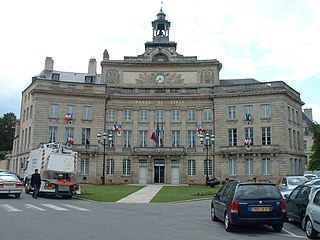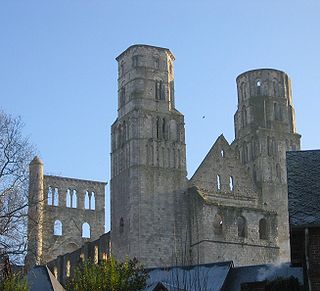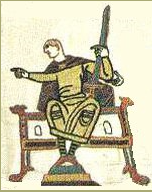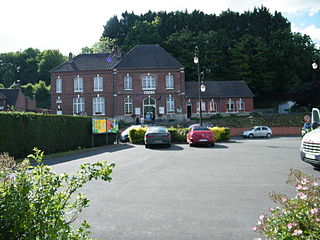
Blainville-Crevon is a commune in the Seine-Maritime département of the Normandy region of northern France.

Robert I of Normandy, also known as Robert the Magnificent and by other names, was a Norman noble of the House of Normandy who ruled as duke of Normandy from 1027 until his death in 1035. He was the son of Duke Richard II; the brother of Duke Richard III, against whom he unsuccessfully revolted; and the father of Duke William who became the first Norman king of England in 1066. During his reign, Robert quarrelled with the church—including his uncle Robert, archbishop of Rouen—and meddled in the disorder in Flanders. He finally reconciled with his uncle and the church, restoring some property and undertaking a pilgrimage to Jerusalem, during which he died.

Orderic Vitalis was an English chronicler and Benedictine monk who wrote one of the great contemporary chronicles of 11th- and 12th-century Normandy and Anglo-Norman England. Modern historians view him as a reliable source.

Alençon is a commune in Normandy, France, capital of the Orne department. It is situated 173 kilometres (107 mi) west of Paris. Alençon belongs to the intercommunality of Alençon.

Alan III of Rennes was Count of Rennes and duke of Brittany, by right of succession from 1008 to his death.

William III of Ponthieu also called William Talvas. He was seigneur de Montgomery in Normandy and Count of Ponthieu.
Dudo, or Dudon, was a Picard historian, and dean of Saint-Quentin, where he was born about 965. Sent in 986 by Albert I, Count of Vermandois, on an errand to Richard I, Duke of Normandy, he succeeded in his mission, and, having made a very favorable impression at the Norman court, spent some years in that country. During a second stay in Normandy, Dudo wrote his history of the Normans, a task which Duke Richard had urged him to undertake. Very little else is known about his life, except that he died before 1043.

Jumièges is a commune in the Seine-Maritime department in the Normandy region in north-western France.

Gesta Normannorum Ducum is a chronicle originally created by the monk William of Jumièges just before 1060. In 1070 William I had William of Jumièges extend the work to detail his rights to the throne of England. In later times, Orderic Vitalis and Robert of Torigni, extended the volumes to include history up until Henry I.

Guy I of Ponthieu was born sometime in the mid- to late 1020s and died 13 October 1100. He succeeded his brother Enguerrand as Count of Ponthieu.

Robert of Torigni was a Norman monk, prior, abbot and twelfth-century chronicler.

William of Jumièges was a contemporary of the events of 1066, and one of the earliest writers on the subject of the Norman conquest of England. He is himself a shadowy figure, only known by his dedicatory letter to William the Conqueror as a monk of Jumièges. Since he also mentions that he was an eyewitness of some events from the reign of Duke Richard III (1026-7), it seems reasonable to assume that he was born some time about the year 1000. He probably entered the monastery during the first quarter of the eleventh century and received his education from Thierry de Mathonville. According to Orderic Vitalis, William's nickname was "Calculus". The meaning behind this nickname is unknown. His death, after 1070, is unrecorded. He was a Norman writing from a Norman point of view. Although only a monk with evidently no military training, he wrote with pride in the accomplishments of his people.

Lammerville is a commune in the Seine-Maritime department in the Normandy region in northern France.

Saint-Vigor-d'Ymonville is a commune in the Seine-Maritime department in the Normandy region in northern France.

Incheville is a commune in the Seine-Maritime department in the Normandy region in northern France.
Beaussault is a commune in the Seine-Maritime department in the Normandy region in northern France.
Anvéville is a commune in the Seine-Maritime department in the Normandy region in northern France.
John of Avranches was bishop of Avranches from 1060 to 1067, and archbishop of Rouen from 1067 to 1079. He was a Norman churchman, son of Rodulf of Ivry, and brother of Hugh of Bayeux. He appears in the Gesta Normannorum Ducum of William of Jumièges, and may have been one of the sources William used.

Mauger was born around 1019 near Dieppe. He was the younger son of Richard II, Duke of Normandy, and his second wife, Papia of Envermeu.
Sprota was an early 10th century woman of obscure origin who became wife 'in the Viking fashion' of William I, Duke of Normandy, by her becoming mother of his successor, Duke Richard I. After the death of William, she married a wealthy landowner, Esperleng, by him having another son, Norman nobleman Rodulf of Ivry.















